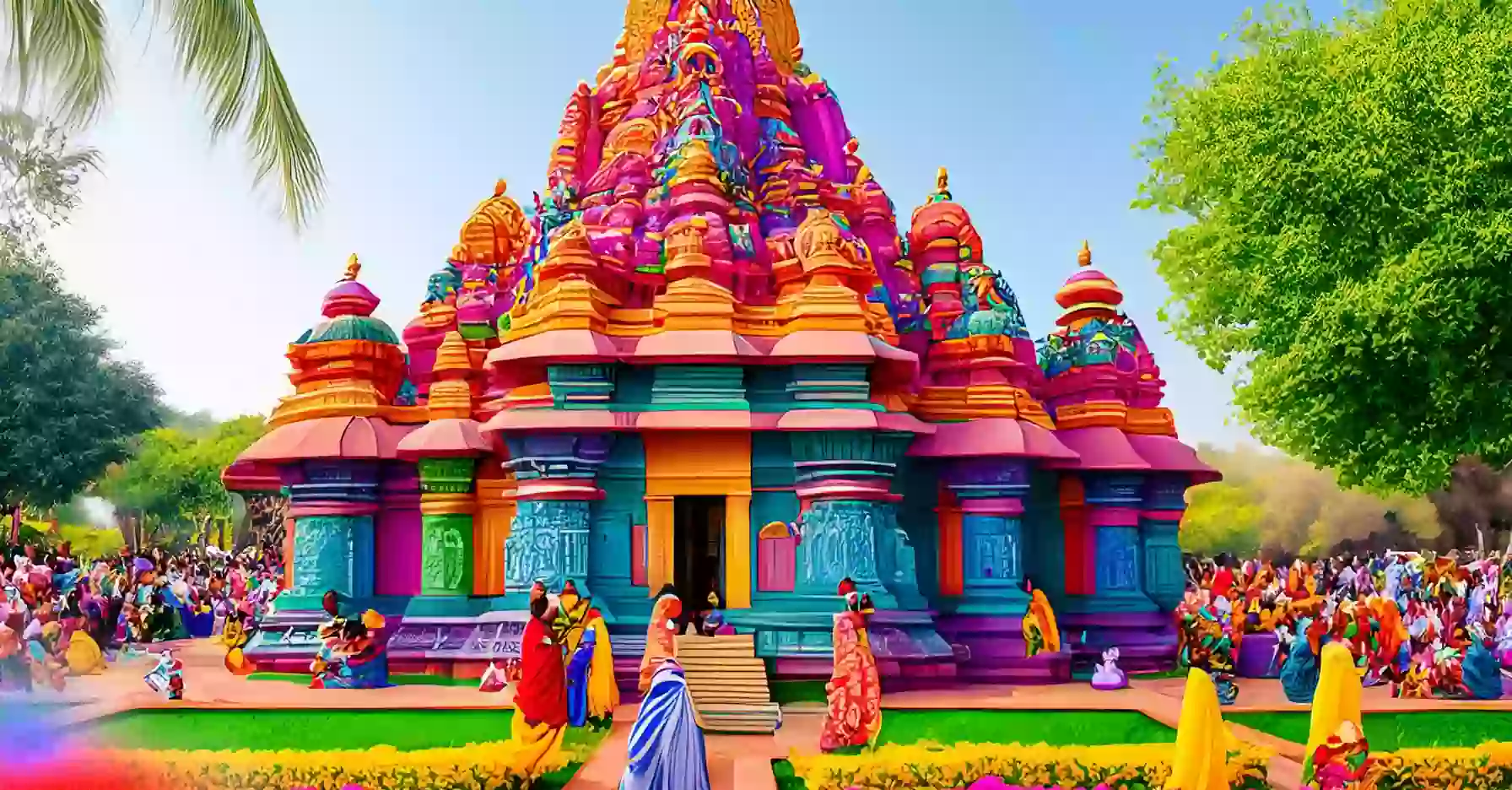India, a land of diverse cultures and traditions, is known for its rich religious heritage. The country is home to a multitude of religions, each with its own unique beliefs, practices, and followers. From ancient indigenous religions to major world religions, India’s spiritual landscape is a tapestry of faiths that have shaped its history and continue to influence its present. In this article, we will delve into India’s main religion, exploring its origins, teachings, and significance in the lives of millions of people.
India’s main religion.
India’s main religion is Hinduism, which is the oldest religion in the world and has the largest religious grouping in India, with around 966 million adherents as of 2011, composing 79.8% of the population. However, India’s spiritual landscape is diverse, and the country is also the birthplace of three other major religions: Buddhism, Jainism, and Sikhism, which are collectively known as native Indian Religions or Dharmic Religions.
Islam is the second-largest religion in India, with 14.2% of the country’s population or roughly 172 million people identifying as adherents of Islam. Religion plays a major role in the Indian way of life, and rituals, worship, and other religious activities are very prominent in an individual’s daily life.
Here are some quick facts about religion in India:
- India is home to the world’s most impressive religious diversity.
- About 80% of the population practices Hinduism, with Islam being the second most practiced religion.
- Four of the world’s major religions were born in India: Hinduism, Buddhism, Jainism, and Sikhism.
- India’s religious diversity has created a unique culture with tons of religious places and festivals that create a unique environment.
- India is home to about 94% of the world’s Hindus.
Understanding India’s main religion is important for grasping Indian ways of living, as Hinduism governs most aspects of life. Religion in India is a complex and diverse tapestry of faiths that have evolved over centuries and have left an indelible mark on the country’s cultural fabric1.
Origin of Hinduism.
Hinduism is the world’s oldest religion, originating in the Indus Valley civilization around 4000 to 1000 BCE. It has no single founder or prophet. The Rig Veda, composed around 1700 BCE, is one of the oldest texts of Hinduism. Early Hindus likely worshipped nature gods like Indra and Agni.
Over time, Brahmanical priests dominated religious life. Hinduism absorbed various local traditions as it spread. Major developments include the Upanishads, Bhagavad Gita, Puranas, and devotional movements led by saints.
2. Core Beliefs of Hinduism.
Some key beliefs in Hinduism include:
- Brahman – One supreme absolute reality
- Atman – The true self, eternal soul within
- Samsara – Cycle of birth, death and rebirth
- Karma – Law of cause and effect of actions
- Dharma – Eternal order, duties, ethics, virtues
- Moksha – Liberation from the cycle of samsara
- Divine manifestations – Gods and goddesses as forms of Brahman
Hinduism believes the ultimate goal is moksha – freedom from the cycle of samsara by realizing oneness with Brahman.
3. Main Hindu Gods and Goddesses.
The major Hindu gods and goddesses are:
- Brahma – The Creator
- Vishnu – The Preserver
- Shiva – The Destroyer
- Saraswati – Goddess of Knowledge
- Lakshmi – Goddess of Wealth and Prosperity
- Parvati – Divine consort of Shiva
- Ganesha – Remover of Obstacles
- Hanuman – Devotee of Rama
- Krishna – Supreme God, teacher of the Bhagavad Gita
- Durga – Warrior goddess, defeater of demons
- Kali – Fierce form of Devi
- Rama – Ideal man, hero of the Ramayana
- Surya – Sun God
Hindus believe in many gods who are forms of the one divine Brahman. The trimurti gods of Brahma, Vishnu and Shiva embody creation, preservation and destruction.
4. Caste System in Hinduism.
The caste system divides Hindus into four main groups – Brahmins, Kshatriyas, Vaishyas and Shudras. Dalits or untouchables were excluded from the caste system. Brahmins were priests and scholars. Kshatriyas were rulers, administrators and warriors.
Vaishyas were merchants, traders, agriculturists. Shudras were artisans and labourers. The caste one is born into determines social standing and appropriate occupations. The caste system has origins in the Rig Vedic period, and was formalized by the time of the Manusmriti. It remains controversial today.
5. Influence of Hinduism on Indian Culture.
Hinduism has deeply influenced Indian philosophy, literature, arts, music and dance. Concepts like karma, dharma, moksha permeate Indian thinking. Classical dance forms like Bharatanatyam, Kathak, Odissi originate from stories about Hindu gods and goddesses. Indian music integrates Hindu bhajans and shlokas.
Sculptures on Hindu temples depict Hindu myths. Hindu festivals like Diwali, Holi and Durga Puja are celebrated by all Indians. The epics Ramayana and Mahabharata are part of Indian heritage. In short, Hindu ethos forms the backbone of Indian culture.
6. Role of Religion in Indian Politics.
Religion plays a major role in Indian politics. The Indian independence movement had strong Hindu influences with leaders like Gandhi promoting Hindu-Muslim unity. The Partition led to communal tensions. Political parties like BJP promote Hindutva ideology.
Parties like DMK, AIADMK represent Dravidian nationalism. The Babri Masjid demolition in 1992 sparked Hindu-Muslim conflicts. Many parties indulge in faith-based mobilization of voters. Religious minority welfare is an issue. While India is a secular democracy, religion continues to assert a strong influence on politics.
7. Relationship between Hinduism and Buddhism.
Buddhism originated in the 6th century BCE as a reaction to some key Hindu doctrines. Buddha rejected the authority of the Vedas, Brahmanical rituals, the caste system and idea of Atman. At the same time, Buddhism borrowed concepts like karma, dharma, moksha and rebirth from Hinduism.
Hindus consider Buddha to be an incarnation of Vishnu. Buddhism declined in India by the 12th century CE. While the two religions differ on key philosophical issues, they share a long history in India, with many cultural intersections.
8. Relationship between Hinduism and Sikhism.
Sikhism originated in the 15th century in Punjab. The Sikh Gurus rejected blind ritualism, caste system and idol worship of Hinduism. They preached devotion to One God. However, Sikhism was influenced by Hindu bhakti tradition emphasizing personal devotion. Concepts like karma and dharma are common to both.
Sikh scripture references Hindu epics and teachings. While philosophically distinct, Hinduism and Sikhism influenced each other culturally in India and continue to interact. The religions have common ancient roots in the Indian subcontinent.
9. Relationship between Hinduism and Jainism.
Jainism originated in India around the 6th century BCE. It rejects the authority of the Hindu Vedas, sacrifices and caste system. Jains believe in asceticism, non-violence and rebirth, with the goal of liberation of the soul. However, concepts like karma, dharma and moksha were absorbed from Hinduism.
Mahavira, the founder of Jainism, was believed to be a contemporary of Buddha. Hindu and Jain mythology share common figures. Jain temples resemble Hindu temples. The religions influenced each other, especially in Gujarat, Rajasthan and South India where Jains have stronger presence.
10. Relationship between Hinduism and Islam.
The interaction between Hinduism and Islam begins with the arrival of Arab traders and the Delhi Sultanate in the Indian subcontinent. Islam rejects idolatry and believes in one formless God. Hinduism has polytheism and iconic worship. Politically and culturally, the two religions have had a complex relationship in South Asian history.
Rulers like Akbar promoted tolerance, whereas Aurangzeb was intolerant of Hindus. Syncretic traditions like Sufism incorporated Hindu practices. Hindu-Muslim clashes occurred during Partition and persist today. However, both religions have had cultural and philosophical impacts on each other in India.
11. Relationship between Hinduism and Christianity.
The Christianity-Hinduism encounter traces back to the arrival of European missionaries in India during the colonial era. Christianity believes in one eternal God, while Hinduism is polytheistic. Christianity preaches salvation through Jesus Christ, while Hinduism focuses on karma and moksha. Under the British Raj, Hindus were concerned about missionary conversions.
However, Hinduism also influenced Christian thinkers. In the 20th century, reforms like Brahma Samaj incorporated Christian ideals. Today, there is still tension around conversions in some areas, but also dialogue on shared moral values between the two faiths.
12. Role of Women in Hinduism.
The role of women in Hinduism has evolved, with patriarchal traditions predominating today. In the Vedic age, women like Maitreyi were learned in the Vedas. The Devi Mahatmya elevated the Divine Mother. Shaktas worship Shakti or female energy.
However Hindu texts like Manusmriti limited women’s rights. Practices like sati, child marriage arose. Reformers like Vivekananda advocated women’s education. Today Hindu women have made strides in education, arts, politics, business though discrimination persists. Hindu law reforms now protect women’s rights to inheritance. Goddesses continue to be worshipped widely for blessings.
13. Significance of the Ganges River in Hinduism.
The Ganges is the holiest river for Hindus. The goddess Ganga is worshipped for purification, fertility and salvation. Key rituals are performed on the banks of the river in Varanasi, Haridwar, Prayagraj.
Drinking Ganga jal and immersion of ashes in the river are believed to lead souls to moksha. The Kumbh Mela, Ardh Kumbh Mela and Chhath Puja are celebrated on the Ganges with mass pilgrimage and worship. The river remains integral to the spiritual geography of India. Environmental campaigns now focus on cleaning up the polluted river.
14. Significance of the Cow in Hinduism.
Hindus revere cows due to their sacrificial, medicinal and economic utility. Cows symbolize dharma, strength, motherhood and non-violence. Lord Krishna was a cowherd. Products like milk, curd, ghee and dung have ritual uses. Killing cows is taboo in mainstream Hinduism.
The cow protection movement started in the late 19th century. Cow slaughter is banned in most Indian states. However controversy erupts over cattle trade and consumption of beef, giving rise to vigilantism. The cow has become a symbol of communal politics around Hindu identity in modern India.
15. Significance of Diwali in Hinduism.
Diwali is the festival of lights celebrated by Hindus, Sikhs, Jains and Buddhists. The five-day Diwali festival honors the return of Lord Rama to Ayodhya after exile. Hindus decorate homes, exchange sweets and worship Lakshmi for prosperity.
The night of Diwali involves lighting lamps, fireworks and festivities. For businesses it marks the start of the new financial year. Diwali symbolizes the triumph of light over darkness, good over evil and hope for the New Year. It is the most awaited and biggest festival celebrated across India.
16. Significance of Holi in Hinduism.
Holi, the vibrant spring festival of colors, has origins in Hindu mythology but is now celebrated widely in India and South Asia. It marks the victory of good over evil, with the burning of Holika pyres. Playing with colors symbolizes the breaking of social barriers and unity.
Holi festivities allow people to mingle freely and release inhibitions. Bhang consumption forms part of some Holi rituals. Music, dance and feasts mark the outdoor celebrations. Holi promotes harmony and heralds the arrival of spring season after winter.
17. Significance of Navratri in Hinduism.
Navratri means nine nights dedicated to the worship of the Hindu goddess Durga and her various forms. People fast, pray, and perform pujas at home or in temples. Navratri celebrates the mother goddess, Shakti, as the embodiment of power and the destroyer of evil.
Navaratri culminates in Vijayadashami or Dussehra when effigies of Ravana are burnt, marking the victory of Rama over Ravana as told in the Ramayana epic. Navratri is celebrated with much fervor all over India, especially in Gujarat where the garba dance is performed.
18. Significance of Dussehra in Hinduism.
Dussehra, also called Vijayadashami, celebrates Lord Rama’s victory over Ravana and the triumph of good over evil. Huge effigies of Ravana are burnt accompanied by fireworks on Vijayadashami. Dussehra also marks the day when Goddess Durga defeated the demon Mahishasura after a fierce battle that lasted nine nights or Navratri.
Dussehra marks the end of Ramlila plays when scenes from the Ramayana are enacted over nine nights. For many Hindus, Dussehra marks the beginning of the new year. It underscores Hindu cultural values of righteousness and devotion to duty.
19. Significance of Raksha Bandhan in Hinduism.
Raksha Bandhan celebrates the loving bond between brothers and sisters. Sisters tie a decorative rakhi thread around the wrists of brothers, who pledge to protect them. Rakhi threads symbolize duty, love and mutual trust. The festival reaffirms cherished family ties.
Sisters pray for their brothers’ health and happiness, while brothers vow to stand up for their sisters. Rakhi threads are sometimes given in platonic friendship too. Raksha Bandhan exemplifies Hindu family values. It is celebrated across India with fervor.
20. Significance of Janmashtami in Hinduism.
Janmashtami is the annual Hindu festival celebrating the birth of Lord Krishna, the eighth avatar of Vishnu. It falls on the eighth day of the Krishna Paksha in Bhadrapada month per the Hindu calendar, usually in August/September.
People fast, sing bhajans, offer prayers to baby Krishna, decorate swings and cradle idols of infant Krishna in his birthplace of Mathura and Vrindavan. The midnight birth celebrations involve devotional dances and feasts. Janmashtami is one of the major Krishna festivals celebrated across India and globally by Hindus.
21. Significance of Kumbh Mela in Hinduism.
The Kumbh Mela is a massive pilgrimage in which Hindus gather at sacred riverside locations to bathe. It is held every 3 years rotating between Allahabad, Haridwar, Nashik and Ujjain. Millions, including sadhus and pilgrims, take the holy dip during this auspicious time.
Kumbh Melas are mentioned in the Puranas as sites of nectar spilling from the kumbha or pot. The festival allows adherents to cleanse sins, achieve moksha and commune with saints. Kumbh Melas demonstrate the grand scale of Hindu faith and sacred geography spanning India’s rivers.
22. Significance of Varanasi in Hinduism.
Varanasi, also known as Kashi and Benares, is regarded as Hinduism’s holiest city due to its location on banks of the sacred Ganga. Varanasi has ancient temples like Kashi Vishwanath dedicated to Shiva, who is said to have founded it. Pilgrims bathe in the Ganga, perform funeral rites and hope for salvation.
The nightly aarti at Dashashwamedh ghat is a spectacle. Varanasi has a special place in Hindu cosmology as a moksha kshetra or place to attain liberation from samsara after death. Many Hindus seek to spend their last days here and get cremated along the city’s ghats.
23. Significance of Ayodhya in Hinduism.
Ayodhya is an ancient city located in present-day Uttar Pradesh that holds great importance in Hindu history and mythology. It is believed to be the birthplace of Lord Rama. Hindus revere it as the setting of the epic Ramayana where Rama ruled.
Ayodhya’s significance has grown as the spot for the disputed Babri Masjid, with Hindu groups claiming this Muslim mosque was built over a temple marking Rama’s birthplace. The proposed Ram Mandir temple project has made Ayodhya the focus of revived Hindu nationalism in India today.
24. Significance of Haridwar in Hinduism.
Haridwar is an important Hindu pilgrimage destination in Uttarakhand where the Ganga emerges from the Himalayas onto the plains. Its location gives it religious significance in Hinduism. As one of the 4 sites of the Kumbh Mela, Haridwar attracts millions of pilgrims for the holy bath during this event.
Other major festivals celebrated here include Somvati Amavasya and Kanwar Mela. Haridwar has temples like Har ki Pauri ghat and Mansa Devi dedicated to the goddess. Pilgrims perform ancestor rituals, puja, take Ganga jal and bathe in the sacred river at Haridwar.
25. Significance of Rishikesh in Hinduism.
Nestled in the Himalayas beside the Ganges, Rishikesh is known as the yoga capital of the world and holds spiritual significance in Hinduism. It is believed to be the place where Raibhya Rishi performed penance and attained moksha. Rishikesh hosts the spectacular Evening Ganga Aarti at Parmarth Niketan and Triveni Ghat.
Important ashrams like Sivananda, Swarg Ashram and Lakshman Jhula attract devotees. The annual International Yoga Festival sees participation by yoga enthusiasts from across the globe. Rishikesh has become a prime destination for spirituality, meditation, wellness and Hindu faith.
26. Significance of Amarnath Yatra in Hinduism.
The Amarnath cave, located in a Himalayan glacier in Kashmir, is considered one of the holiest shrines in Hinduism. Here Lord Shiva is worshipped as a naturally formed ice lingam that waxes and wanes with the moon’s phases. The difficult annual pilgrimage or Yatra to Amarnath cave occurs in July-August.
Devotees must trek and brave high altitudes and weather extremes to glimpse the sacred lingam. Having darshan of the ice lingam is believed to grant blessings, prosperity and moksha. Recent years have witnessed efforts to improve facilities and access for Amarnath Yatra pilgrims.
27. Significance of Char Dham Yatra in Hinduism.
The Char Dham Yatra is an important Hindu pilgrimage circuit in the Himalayas comprising holy shrines in Badrinath, Kedarnath, Gangotri and Yamunotri. It is believed visiting these dhams removes sins and helps attain moksha. Badrinath temple is dedicated to Lord Vishnu.
Kedarnath is a Shiva temple. Gangotri and Yamunotri are the source of both rivers. Char Dham Yatra opens annually between April-May after the winter. Improving infrastructure now allows easier access for thousands of devotees. Uttarakhand promotes the yatra for faith tourism. For Hindus, Char Dham Yatra is a significant spiritual journey.
28. Significance of Chhath Puja in Hinduism.
Chhath Puja is a Hindu festival dedicated to Surya, the Sun God, and Chhathi Maiya. Originating in Vedic times, it is celebrated with fervor in Bihar, Jharkhand and Eastern Uttar Pradesh.
Chhath involves fasting and worship of the rising and setting sun. The elaborate rituals by standing in waterbodies are believed to purify the body and soul. Through Chhath, devotees express gratitude
Conclusion:
India’s main religion is a complex and diverse tapestry of faiths that have evolved over centuries. From Hinduism, the oldest religion in the world, to Buddhism, Jainism, Sikhism, and Islam, each religion has left an indelible mark on the country’s cultural fabric. These religions have not only shaped the lives of millions of people but have also influenced art, architecture, literature, and philosophy.

Understanding India’s main religion is a journey into the heart of its people and their beliefs. It is an exploration of the values, rituals, and traditions that have been passed down through generations.
Whether it is the devotion to multiple deities in Hinduism, the pursuit of enlightenment in Buddhism, or the principles of equality and service in Sikhism, each religion offers a unique perspective on life and spirituality.
As we navigate the diverse spiritual landscape of India, we gain a deeper appreciation for the country’s rich heritage and the role that religion plays in the lives of its people. It is a testament to the power of faith and the human quest for meaning and purpose.
So, join us on this enlightening journey as we unravel the intricacies of India’s main religion and discover the profound impact it has on the lives of millions. Consider reading other articles we wrote about the indian faith >>>>> Do Hindus Believe in God? to learn more.
I am an accomplished author at Fact Finders Company LLC, a renowned publishing house based in New York City. With a passion for research and a talent for writing, I have contributed to numerous non-fiction titles that explore a wide range of topics, from politics and history to science and technology. My work has been widely praised for its accuracy, clarity, and engaging style. Nice Reading here at Fact After Fact.







